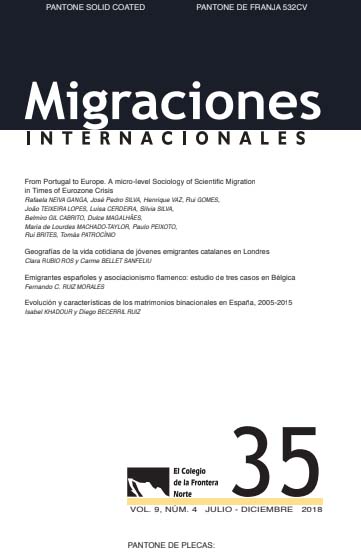US-Mexico Border Militarization and Violence: Dispossession and Disorganization of Undocumented Laboring Classes from Puebla, Mexico
DOI:
https://doi.org/10.17428/rmi.v9i35.444Palabras clave:
violencia, ilegalidad, coyotaje, Estados Unidos, MéxicoResumen
Interviews with return migrants in Puebla, Mexico before and after the massive border build-up of the mid-2000s reveal how increased border enforcement entailed greater risks of arrest and potentiated the violence migrants experienced at the hands of smugglers and criminals, reducing circular migration. Dispossessed of physical security and psychological well-being, illegal mobile bodies create value for multiple accumulation processes: at the point of production as vulnerable workers, as well as commodities for trafficking organizations and private detention centers. The violence inflicted on undocumented border crossers disciplines them for the more exploitative labor relations oftemporary worker programs.
Referencias
Alarcón, R. & Becerra, W. (2012). ¿Criminales o víctimas? La deportación de migrantes mexicanos de Estados Unidos a Tijuana, Baja California. Norteamérica, 7(1), 125–149.
Alonso, G. (2012) Recesión económica, reflujos migratorios y violencia antiinmigrante entre México y Estados Unidos. Norteamérica, 7(2), 221–252.
Andreas, P. (2000). Border games: Policing the U.S.-Mexico divide. Ithaca, NY: Cornell University Press.
Binford, L. (2003a). Migración acelerada entre Puebla y los Estados Unidos. In E. Masferrer, E. Díaz Brenis, & J. Mondragón Melo, (Eds.). Etnografía del Estado de Puebla: Puebla Centro (pp. 58-67). Puebla: Gobierno del Estado de Puebla-Secretaría de Cultura.
Binford, L. (2003b). Migrant Remittances and (Under) Development in Mexico. Critique of Anthropology, 23(3), 305–336.
Binford, L. (2004). La Economía Política de la Migración Internacional en Puebla y Veracruz: Siete Estudios de Caso. Puebla: Benemérita Universidad Autónoma de Puebla-Instituto de Ciencias Sociales y Humanidades.
Binford, L. (2013). Tomorrow We’re All Going to the Harvest: Temporary Foreign Worker Programs and Neoliberal Political Economy. Austin, Texas: University of Texas Press.
Binford, L. & Churchill, N. (2007). Stoneworkers, Masons and Maids: Neoliberal Crisis, Social Fields and Proletarianization in peri-urban Mexico. Critique of Anthropology, 27(4), 359–375.
Coleman, M. (2007). Immigration Geopolitics Beyond the Mexico-US Border. Antipode, 39(1), 54–76.
Cordero Díaz, B. (2007). Ser trabajador transnacional: Clase, hegemonía y cultura en un circuito migratorio internacional. Puebla: Benemérita Universidad Autónoma de Puebla, Instituto de Ciencias Sociales y Humanidades.
Cornelius, W. (2001). Death at the Border: Efficacy and Unintended Consequences of US Immigration Control Policy. Population and Development Review, 27(4), 661–685.
D’Aubeterre Buznego, M. E. and Rivermar Pérez, M. L. (2014). From Amate Paper Making to Global Work: Otomí Migration from Puebla to North Carolina. Latin American Perspectives, 41(3), 118–136.
De Genova, N. (2005). Working the Boundaries: Race, Space, and “Illegality” in Mexican Chicago. Durham, NC: Duke University Press.
Department of Homeland Security. (2008). Budget-in-Brief, Fiscal Year 2009. Washington, D. C. Retrived from http://www.dhs.gov/sites/default/files/publications/budget_bib-fy2009.pdf.
Department of Homeland Security. (2013). Budget in Brief, Fiscal Year 2014. Washington, D. C. Retrived from https://www.dhs.gov/sites/default/files/publications/MGMT/FY%202014%20BIB%20-%20FINAL%20-508%20Formatted%20(4).pdf
Dunn, T. (1996). The militarization of the U.S.-Mexico border, 1978-1992: Low-intensity conflict doctrine comes home. Austin: University of Texas Press.
Espenshade, T. (1994). Does the Threat of Border Apprehension Deter Undocumented US Immigration? Population and Development Review, 20(4), 871–892.
Glick Schiller, N. (2010). A Global Perspective on Migration and Development. In N. Glick Schiller & T. Faist (Eds.). Migration, Development and Transnationalism: A Critical Stance (pp. 24-52). New York, NY: Berghahn Books.
Glick Schiller, N. (2015). Explanatory Frameworks in Transnational Migration Studies : The Missing Multi-scalar Global Perspective. Ethnic and Racial Studies, 38(13), 2275–2282.
Golash-Boza, T. (2009). The Immigration Industrial Complex: Why We Enforce Immigration Policies Destined to Fail. Sociology Compass, 3(2), 295–309.
Golash-Boza, T. (2012). Immigration Nation: Raids, Detentions and Deportations in post-9/11 America. Boulder, CO: Paradigm Publishers.
Gomberg-Munoz, R. and Nussbaum-Barberena, L. (2011). Is Immigration Policy Labor Policy?: Immigration Enforcement, Undocumented Workers, and the State. Human Organization, 70(4), 366–375.
Gonzalez-Barrera, A. (2015). More Mexicans Leaving Than Coming to the U.S. Washington, D.C.: Pew Research Center. Retrieved from http://www.pewhispanic.org/files/2015/11/2015-11-19_mexican-immigration__FINAL.pdf
Government Accountability Office. (2010). Secure Border Initiative: DHS Needs to Strengthen Management and Oversight of its Prime Contractor. Washington, D. C. Retrived from http://www.gao.gov/assets/320/311431.pdf
Griffith, D. (Ed.). (2014). (Mis)Managing migration: Guestworkers’ experiences with North American labor markets. Santa Fe, New México: School for Advanced Research Press.
Hahamovich, C. (2003). Creating Perfect Immigrants: Guestworkers of the World in Historical Perspective. Labor History, 44(1), 69–94.
Harvey, D. (2003). The New Imperialism. Oxford, England: Oxford University Press.
Hennebry, J., & Preibisch, K. (2012). A Model for Managed Migration? Re-Examining Best Practices in Canada’s Seasonal Agricultural Worker Program. International Migration, 50(s1), 19–40.
Heyman, J. (1995). Putting Power in the Anthropology of Bureaucracy: The Immigration and Naturalization Service at the Mexico-United States Border. Current Anthropology, 36(2), 261–287.
Heyman, J. (1998), State Effects on Labor Exploitation. Critique of Anthropology, 18 (2), 157–180.
Heyman, J. (2012). Capitalism and US Policy at the Mexican Border. Dialectical Anthropology 36(3-4), 263-277.
Heyman, J. (2014). ‘Illegality’ and the U.S.-Mexico Border: How it is Produced and Resisted. In C. Menjívar & D. Kanstroom (Eds.), Constructing Immigrant “Illegality”: Critiques, Experiences, and Responses (pp. 111-135). New York, NY: Cambridge University Press.
Hicken, J., Fishbein J. & Lisle, J. (2011). U.S. Border Enforcement: The Limits of Physical and Remote Deterrence of Unauthorized Migration. In D. Fitzgerald, R. Alarcón & L. Muse-Orlinoff (Eds.). Recession Without Borders: Mexican Migrants Confront the Economic Downturn (pp.17-35). La Jolla, CA: Center for Comparative Immigration Studies-University of California San Diego.
Izcara Palacios, S. P. (2015). La transformación del coyotaje en el contexto de políticas migratorias restrictivas. Estudios Sociales, 23(46), 313-340.
Izcara Palacios, S. P. (2016). Violencia postestructural: migrantes centroamericanos y cárteles de la droga en México. Revista de Estudios Sociales, 56, 12-25.
Kandel, W. & Massey, D. (2002). The Culture of Mexican Migration: A Theoretical and Empirical Analysis. Social Forces, 80(3), 981–1004.
Kroll, A. (2013). This Is How Private Prison Companies Make Millions Even As Crime Rates Fall. Retrived from http://www.motherjones.com/mojo/2013/09/private-prisons-occupancy-quota-cca-crime/
Lee, A. (2008). ‘Para salir adelante’: The Emergence and Acceleration of International Migration in New Sending Areas of Puebla, Mexico. Journal of Latin American and Caribbean Anthropology, 13(1), 48–78.
Lydgate, J. (2010). Assembly-Line Justice: A Review of Operation Streamline (Policy Brief - January 2010). Berkeley: Berkeley Law Center- University of California Berkeley. Retreived from https://www.law.berkeley.edu/files/Operation_Streamline_Policy_Brief
Martínez, D., & Slack, J. (2013). What Part of "Illegal" Don't You Understand? The Social Consequences of Criminalizing Unauthorized Mexican Migrants in the United States. Social & Legal Studies, 22(4), 535-551.
Martínez, D., Slack, J., & Heyman, J. (2013). Bordering on Criminal: The Routine Abuse of Migrants in the Removal System. Part I: Migrant Mistreatment While in U.S. Custody (Special Report, December 2013). Washington, D. C.: Immigration Policy Center, American Immigration Council. Retrieved from http://www.immigrationpolicy.org/sites/default/files/docs/ipc/Border-AbusesFINAL.pdf
Martínez, et al. (2013). A Continued Humanitarian Crisis at the Border: Undocumented Border Crosser Deaths Recorded by the Pima County Medical Examiner, 1990-2012. (Technical Report, June 2013). Tucson: Binational Migration Institute, The University of Arizona. doi: 10.2139/ssrn.2633209
Massey, D., Durand, J., & Malone, N. (2002). Beyond Smoke and Mirrors: Mexican Immigration in an Era of Economic Integration. New York, NY: Russell Sage Foundation.
Massey, D., Durand, J. & Pren, K. (2014). Explaining Undocumented Migration to the U.S. International Migration Review, 48(4), 1028–1061.
Meissner, D., Kerwin, D., Chishti, M. & Bergeron, C. (2013). Immigration Enforcement in the United States: The Rise of a Formidable Machinery. Washington, D.C.: Migration Policy Institute. Retrieved from http://www.migrationpolicy.org/research/immigration-enforcement-united-states-rise-formidable-machinery
Menjívar, C. & Abrego, L. (2012). Legal Violence: Immigration Law and the Lives of Central American Immigrants. American Journal of Sociology, 117(5), 1380–1421.
Mexican Migration Project. (1982-2018). Household Level Questionnaires (Ethnosurveys). The MMP is a collaborative research project based at the Princeton University and the University of Guadalajara. Princeton, NJ, Guadalajara, México: Mexican Migration Project. Retrieved https://mmp.opr.princeton.edu/home-en.aspx
Nevins, J. (2010) Operation Gatekeeper and Beyond: The War on “Illegals” and the Remaking of the U.S.-Mexico Boundary (2nd. edition). New York, NY: Routledge.
O’Leary, A. (2009). In the Footsteps of Spirits: Migrant Women’s Testimonios in a Time of Heightened Border Enforcement. In K. Staudt, T. Payan, & Z. A. Kruszewski (Eds.), Human Rights along the U.S.-Mexico Border: Gendered Violence and Insecurity (pp. 85–104). Tucson: University of Arizona Press.
Passel, J., Cohn, D., & Gonzalez-Barrera, A. (2012). Net Migration from Mexico Falls to Zero — and Perhaps Less. Washington, D.C.: Pew Hispanic Center. Retreieved from http://www.pewhispanic.org/2012/04/23/net-migration-from-mexico-falls-to-zero-and-perhaps-less
Ramírez García, T. & Meza González, L. (2012). Emigración México-Estados Unidos: balance antes y después de la recesión económica estadounidense. In Consejo Nacional de Población (Ed.). La Situación Demográfica en México 2011 (pp. 241–259). México City: Consejo Nacional de Población. Retrieved from http://www.conapo.gob.mx/es/CONAPO/La_situacion_demografica_de_Mexico__2011
Rubio-Goldsmith, R., McCormick, M., Martinez, D. & Duarte, I. (2006). The “Funnel Effect” and the Recovered Bodies of Unauthorized Migrants Processed by the Pima County Office of the Medical Examiner, 1990-2005 (Report submitted to the pima county board of supervisors). Tucson, Arizona: Binational Migration Institute - University of Arizona.
Sabo, S., et al. (2014). Everyday Violence, Structural Racism and Mistreatment at the US-Mexico Border. Social Science & Medicine, 109, 66–74.
Simmons, W., Menjivar, C. & Tellez, M. (2015). Violence and Vulnerability of Female Migrants in Drop Houses in Arizona: The Predictable Outcome of a Chain Reaction of Violence. Violence Against Women, 21(5), 551–570.
Slack, J. (2015). Captive Bodies: Migrant Kidnapping and Deportation in Mexico. Area, 48(3), 271-277. doi: 10.1111/area.12151
Slack, J., Martinez, D., Lee, A. & Whiteford, S. (2016). The Geography of Border Militarization: Violence, Death and Health in Mexico and the United States. Journal of Latin American Geography, 15(1), 7–32.
Slack, J., Martinez, D., Whiteford, S., & Peiffer, E. (2013). In the Shadow of the Wall: Family Separation, Immigration Enforcement and Security (Final Report 2013). Tucson: Center for Latin American Studies-University of Arizona. Retrieved from http://las.arizona.edu/sites/las.arizona.edu/files/UA_Immigration_Report2013web.pdf
Slack, J. & Whiteford, S. (2011). Violence and Migration on the Arizona-Sonora Border. Human Organization, 70(1), 11–21.
Spener, D. (2009). Clandestine Crossings: Migrants and Coyotes on the Texas-Mexico Border. Ithaca, NY: Cornell University Press.
Stumpf, J. (2006). The Crimmigration Crisis: Immigrants, Crime and Sovereign Power. American University Law Review, 56(2), 367–419.
Varsanyi, M. (2010). Taking Local Control: Immigration Policy Activism in U.S. Cities and States. Stanford, CA: Stanford University Press.
Vogt, W. (2013). Crossing Mexico: Structural Violence and the Commodification of Undocumented Central American Migrants. American Ethnologist, 40(4), 764–780.
Descargas
Publicado
Número
Sección
Licencia
Derechos de autor 2018 Migraciones Internacionales

Esta obra está bajo una licencia internacional Creative Commons Atribución-NoComercial-SinDerivadas 4.0.
Las/los autoras/es que publiquen en esta revista aceptan las siguientes condiciones:
- Las/los autoras/es conservan los derechos de autor y ceden a la revista Migraciones Internacionales (RMI) el derecho de la primera publicación, mediante el registro de los textos con la licencia de Creative Commons Atribución-No comercial-Sin derivar 4.0 internacional (CC BY-NC-ND 4.0), que permite a terceros utilizar lo publicado siempre que mencionen la autoría del trabajo y a la primera publicación en esta revista.
- Autorizan que su artículo y todos los materiales incluidos en él sean reproducidos, publicados, traducidos, comunicados y transmitidos públicamente en cualquier forma o medio; así como efectuar su distribución al público en el número de ejemplares que se requieran y su comunicación pública, en cada una de sus modalidades, incluida su puesta a disposición del público a través de medios electrónicos o de cualquier otra tecnología, para fines exclusivamente científicos, culturales, de difusión y sin fines comerciales.
- Los autores/as pueden realizar otros acuerdos contractuales independientes y adicionales para la distribución no exclusiva de la versión del artículo publicado en esta revista (por ejemplo: incluirlo en un repositorio institucional, página web personal; o bien publicarlo en un libro) siempre que sea sin fines comerciales e indiquen claramente que el trabajo se publicó por primera vez en Migraciones Internacionales (RMI), [agregando la ficha bibliográfica correspondiente: Autor/es. (año). Título del artículo. Migraciones Internacionales, volumen (número), pp. doi: xxxx ].
Para ello, las/los autoras/es deben remitir el formato de carta-cesión de la propiedad de los derechos de la primera publicación debidamente llenado y firmado. Este documento debe cargarse en formato PDF en archivos complementarios dentro de la plataforma OJS.
Este obra está bajo una licencia de Creative Commons Atribución-No comercial-Sin derivar 4.0 internacional (CC BY-NC-ND 4.0)..













